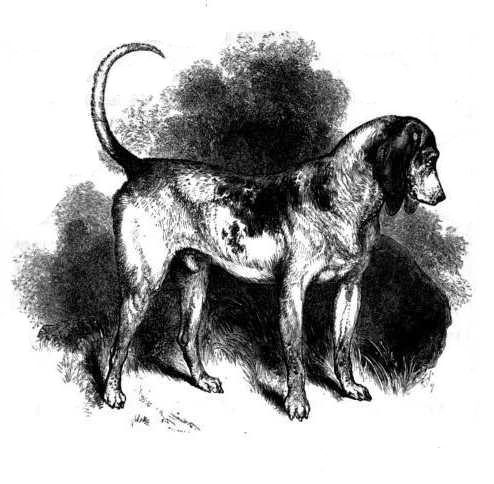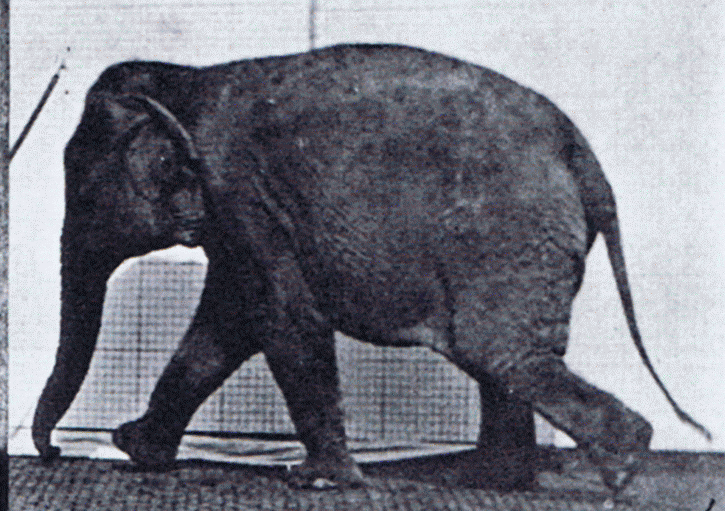|
Musladin-Lueke Syndrome
Musladin-Lueke syndrome (previously known as Chinese Beagle syndrome) is a hereditary disorder that affects beagles that manifests in extensive fibrosis of the skin and joints. It is named after beagle breeders Anton Musladin and Ada Leuke. It is caused by a number of recessive mutations affecting fibrillin-1, a major component of microfibrils. It affects several organ systems An organ system is a biological system consisting of a group of organs that work together to perform one or more functions. Each organ has a specialized role in a plant or animal body, and is made up of distinct tissues. Plants Plants have ..., including the skeleton, heart, skin, and muscle. According to the American Kennel Club's Canine Health Foundation, "beagles with Musladin-Leuke syndrome are born with several defects characterized by short outer toes on the front and sometimes all four feet, high set creased ears on a flat skull with extra cartilage in them, slant narrowed eyes, and very thic ... [...More Info...] [...Related Items...] OR: [Wikipedia] [Google] [Baidu] |
Hereditary Disorder
A genetic disorder is a health problem caused by one or more abnormalities in the genome. It can be caused by a mutation in a single gene (monogenic) or multiple genes (polygenic) or by a chromosomal abnormality. Although polygenic disorders are the most common, the term is mostly used when discussing disorders with a single genetic cause, either in a gene or chromosome. The mutation responsible can occur spontaneously before embryonic development (a ''de novo'' mutation), or it can be inherited from two parents who are carriers of a faulty gene (autosomal recessive inheritance) or from a parent with the disorder (autosomal dominant inheritance). When the genetic disorder is inherited from one or both parents, it is also classified as a hereditary disease. Some disorders are caused by a mutation on the X chromosome and have X-linked inheritance. Very few disorders are inherited on the Y chromosome or mitochondrial DNA (due to their size). There are well over 6,000 known genet ... [...More Info...] [...Related Items...] OR: [Wikipedia] [Google] [Baidu] |
Beagle
The beagle is a breed of small scent hound, similar in appearance to the much larger foxhound. The beagle was developed primarily for hunting hare, known as beagling. Possessing a great sense of smell and superior tracking instincts, the beagle is the primary breed used as a detection dog for prohibited agricultural imports and foodstuffs in quarantine around the world. The beagle is intelligent and is a popular pet due to its size, good temper, and a lack of inherited health problems. The modern breed was developed in Great Britain around the 1830s from several breeds, including the Talbot Hound, the North Country Beagle, the Southern Hound, and possibly the Harrier. Beagles have been depicted in popular culture since Elizabethan times in literature and paintings and more recently in film, television, and comic books. History The origin of the beagle is not known. In the 11th century, William the Conqueror brought the St. Hubert Hound and the Talbot hound to ... [...More Info...] [...Related Items...] OR: [Wikipedia] [Google] [Baidu] |
Recessive
In genetics, dominance is the phenomenon of one variant (allele) of a gene on a chromosome masking or overriding the effect of a different variant of the same gene on the other copy of the chromosome. The first variant is termed dominant and the second recessive. This state of having two different variants of the same gene on each chromosome is originally caused by a mutation in one of the genes, either new (''de novo'') or inherited. The terms autosomal dominant or autosomal recessive are used to describe gene variants on non-sex chromosomes ( autosomes) and their associated traits, while those on sex chromosomes (allosomes) are termed X-linked dominant, X-linked recessive or Y-linked; these have an inheritance and presentation pattern that depends on the sex of both the parent and the child (see Sex linkage). Since there is only one copy of the Y chromosome, Y-linked traits cannot be dominant or recessive. Additionally, there are other forms of dominance such as incomplete d ... [...More Info...] [...Related Items...] OR: [Wikipedia] [Google] [Baidu] |
Mutation
In biology, a mutation is an alteration in the nucleic acid sequence of the genome of an organism, virus, or extrachromosomal DNA. Viral genomes contain either DNA or RNA. Mutations result from errors during DNA replication, DNA or viral replication, mitosis, or meiosis or other types of DNA repair#DNA damage, damage to DNA (such as pyrimidine dimers caused by exposure to ultraviolet radiation), which then may undergo error-prone repair (especially microhomology-mediated end joining), cause an error during other forms of repair, or cause an error during replication (DNA repair#Translesion synthesis, translesion synthesis). Mutations may also result from Insertion (genetics), insertion or Deletion (genetics), deletion of segments of DNA due to mobile genetic elements. Mutations may or may not produce detectable changes in the observable characteristics (phenotype) of an organism. Mutations play a part in both normal and abnormal biological processes including: evolution, cancer ... [...More Info...] [...Related Items...] OR: [Wikipedia] [Google] [Baidu] |
Microfibril
A microfibril is a very fine fibril, or fiber-like strand, consisting of glycoproteins and cellulose. It is usually, but not always, used as a general term in describing the structure of protein fiber, e.g. hair and sperm tail. Its most frequently observed structural pattern is the 9+2 pattern in which two central protofibrils are surrounded by nine other pairs. Cellulose inside plants is one of the examples of non-protein compounds that are using this term with the same purpose. Cellulose microfibrils are laid down in the inner surface of the primary cell wall. As the cell absorbs water, its volume increases and the existing microfibrils separate and new ones are formed to help increase cell strength. Synthesis and function Cellulose is synthesized by cellulose synthase or Rosette terminal complexes which reside on a cells membrane. As cellulose fibrils are synthesized and grow extracellularly they push up against neighboring cells. Since the neighboring cell can not move easily ... [...More Info...] [...Related Items...] OR: [Wikipedia] [Google] [Baidu] |
Dog Anatomy
Dog anatomy comprises the anatomical studies of the visible parts of the body of a domestic dog. Details of structures vary tremendously from breed to breed, more than in any other animal species, wild or domesticated, as dogs are highly variable in height and weight. The smallest known adult dog was a Yorkshire Terrier that stood only at the shoulder, in length along the head and body, and weighed only . The heaviest dog was an English Mastiff named Zorba which weighed . The tallest known adult dog is a Great Dane that stands at the shoulder. Anatomy Source: Muscles The following is a list of the muscles in the dog, along with their origin, insertion, action and innervation. ''Extrinsic muscles of the thoracic limb and related structures:'' Descending superficial pectoral: originates on the first sternebrae and inserts on the greater tubercle of the humerus. It both adducts the limb and also prevents the limb from being abducted during weight bearing. It is innervated b ... [...More Info...] [...Related Items...] OR: [Wikipedia] [Google] [Baidu] |
American Kennel Club
The American Kennel Club (AKC) is a registry of purebred dog pedigrees in the United States. In addition to maintaining its pedigree registry, this kennel club also promotes and sanctions events for purebred dogs, including the Westminster Kennel Club Dog Show, an annual event which predates the official forming of the AKC, the National Dog Show and the AKC National Championship. The AKC is a non-member partner with the Fédération Cynologique Internationale. The AKC recognizes 200 dog breeds, as of 2022. History In the early 1800s, the English became concerned with the beauty of dogs as well as their function. This fad spread to North America, and in 1877, the Westminster Kennel Club Dog Show began. Soon after, the need for a regulating body became obvious. The National American Kennel Club, which had been founded in 1876, began to publish and make publicly available its studbook in 1879. This organization, however, had a more vested interest in field trials than in confor ... [...More Info...] [...Related Items...] OR: [Wikipedia] [Google] [Baidu] |
Gait
Gait is the pattern of movement of the limbs of animals, including humans, during locomotion over a solid substrate. Most animals use a variety of gaits, selecting gait based on speed, terrain, the need to maneuver, and energetic efficiency. Different animal species may use different gaits due to differences in anatomy that prevent use of certain gaits, or simply due to evolved innate preferences as a result of habitat differences. While various gaits are given specific names, the complexity of biological systems and interacting with the environment make these distinctions "fuzzy" at best. Gaits are typically classified according to footfall patterns, but recent studies often prefer definitions based on mechanics. The term typically does not refer to limb-based propulsion through fluid mediums such as water or air, but rather to propulsion across a solid substrate by generating reactive forces against it (which can apply to walking while underwater as well as on land). Due to ... [...More Info...] [...Related Items...] OR: [Wikipedia] [Google] [Baidu] |
Footnotes
A note is a string of text placed at the bottom of a page in a book or document or at the end of a chapter, volume, or the whole text. The note can provide an author's comments on the main text or citations of a reference work in support of the text. Footnotes are notes at the foot of the page while endnotes are collected under a separate heading at the end of a chapter, volume, or entire work. Unlike footnotes, endnotes have the advantage of not affecting the layout of the main text, but may cause inconvenience to readers who have to move back and forth between the main text and the endnotes. In some editions of the Bible, notes are placed in a narrow column in the middle of each page between two columns of biblical text. Numbering and symbols In English, a footnote or endnote is normally flagged by a superscripted number immediately following that portion of the text the note references, each such footnote being numbered sequentially. Occasionally, a number between brack ... [...More Info...] [...Related Items...] OR: [Wikipedia] [Google] [Baidu] |




